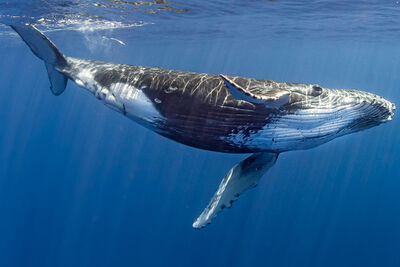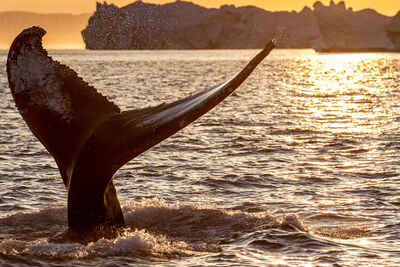You've heard of epic land migrations (hello, wildebeests), but what about those that happen beneath the waves? Every year, marine species great and small undertake mighty migratory journeys across the ocean in search of food or a mate, or both. From wandering whales to cruising sea turtles, read on for some of our favourite ocean migrations and where to find them…

Humpback whales
When: Winter months
Where: Near the equator, including around the Caribbean and Hawaii
Kicking off the list of our favourite ocean migrations is one of its gentle giants, the humpback whale. These majestic creatures complete one of the longest annual migrations of any marine mammal, travelling up to a whopping 5,000 miles to breed. During the summer, humpbacks hang out in cold, high-latitude waters around the poles, where they feast in preparation for the big swim. The whales then make the journey to warmer, tropical waters around the equator to breed and calve during the winter months.
Humpbacks aren't the speediest swimmers in the sea, so their migration can take up to two months to complete. On the plus side, they don't need to feed en route; instead, they rely on their blubber reserves for the duration of the trip.
Pacific bluefin tuna
When: April-August
Where: Philippine Sea, Sea of Japan
Thanks to its ability to auto-regulate its body temperature, the Pacific bluefin tuna is made for migrations, as it's capable of thriving in a wide range of ocean temperatures. These pelagic predators spawn in the waters around the Philippine Sea and the Sea of Japan between April and August. Before they reach maturity at around seven years old, juvenile tuna embark on a herculean journey of over 5,000 miles across the Pacific Ocean to the North American coast, where they stay for a few years to feed and grow (sometimes up to ten feet long).

Grey whales
When: December-April
Where: West coast of North America
Like their humpback cousins, grey whales also undertake a mammoth migration every year. Their summers are spent feeding in the icy Arctic waters until food becomes scarce and temperatures plummet. Then, they swim south down the west coast of North America to breed and calve in the balmy lagoons of Baja California, Mexico (we don't blame them). Their round-trip can cover as many as 10,000 to 14,000 miles, swimming at a leisurely five miles per hour.
During the migration, grey whales tend to stick close to the shore for safety, meaning that you'll have a good chance of spotting these migratory marine mammals from the California coast between December and April.
Sardines
When: May-July
Where: East coast of South Africa
Ocean migrations aren't reserved for massive marine species. Every year between May and July, billions (yes, billions) of cold-water sardines migrate along the east coast of South Africa, following the chilly nutrient-rich currents north. The result? A fantastic feeding frenzy. These enormous shoals of shimmering sardines attract a diverse array of predators, including dolphins, sharks, birds and seals. If you fancy getting in on the fishy action, we recommend heading out on a boat or on a snorkelling or diving trip in South African hotspots such as Port St. Johns and Coffee Bay.

Sea turtles
When: Nesting in spring and summer
Where: Tropical regions such as Costa Rica and Florida
Did you know that sea turtles are highly migratory animals? Finding Nemo isn't all fiction. Upon reaching maturity, sea turtles migrate great distances across the open ocean between feeding and breeding grounds, typically nesting on the same beaches where they were born, in tropical and subtropical regions. When it comes to going the distance, leatherback sea turtles lead the way, travelling up to 10,000 miles a year in search of tasty jellyfish to feast on. Loggerheads aren't far behind, swimming some 8,000 miles to feed. Talk about earning a meal…
Whale sharks
When: Year-round in different destinations
Where: Regions include the Maldives, Mexico, Galapagos and Ningaloo Reef, Western Australia
Last but by no means least on our list are everyone's favourite big fish: whale sharks. These graceful giants swim huge distances across the world, but their reasons for doing so remain a mystery. Despite knowing so little about their life cycles, researchers believe that feeding, breeding and climate are likely motivators for movement. So, where can you spot these majestic migrating creatures? Among other destinations, whale sharks migrate to the waters around Ningaloo Reef, Western Australia, between March and July, where a coral spawning event fills the waters with plentiful plankton (a.k.a., a whale shark's favourite snack).
















